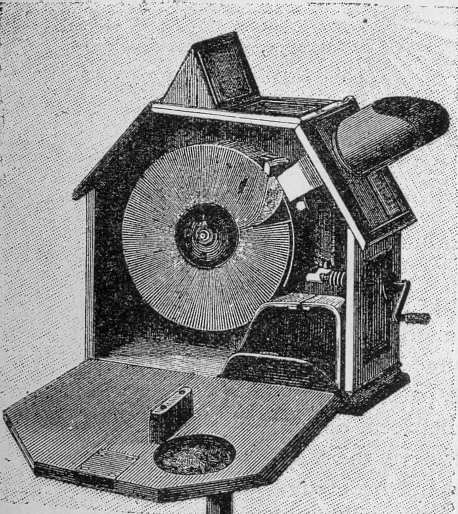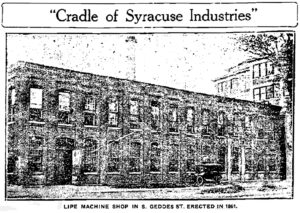
In 1898, Thomas Edison sued the American Mutoscope and Biograph Company, claiming that they had infringed on his patent for the Kinetograph movie camera. According to the book Our Movie Houses: A History of Film and Cinematic Innovation in Central New York by Norman O. Keim, W.L.K. Dickson, who worked with Edison on the design of the Kinetograph and Kinetoscope, left Edison’s shop when he was angered that “Edison had not given him adequate credit for his work.” Shortly after, Dickson went on to help Edison’s competitors develop another motion-picture device: the Mutoscope. Dickson was soon fired by Edison after learning of the situation. The company Dickson would go on to work for, the American Mutoscope and Biograph Company, has roots in Syracuse as well as the Mutoscopes themselves, which were perfected by Dickson and constructed by Herman Casler, the cousin of Charles E. Lipe, at the C.E. Lipe Machine Shop on Geddes Street [pictured below]. Casler was a Central New York Pioneer in Early Cinema Equipment and the inventor of the Mutoscope, Biograph Camera, and projector.
 Thomas Edison would go on to lose the lawsuit after nearly ten years of legal battles. Interestingly enough, however, The American Mutoscope and Biograph Company eventually joined forces with Edison’s Motion Picture Patents Company in 1909, a trust of all the major American film companies. However, the trust was dissolved by the U.S. Supreme Court after it was deemed the company was a monopoly.
Thomas Edison would go on to lose the lawsuit after nearly ten years of legal battles. Interestingly enough, however, The American Mutoscope and Biograph Company eventually joined forces with Edison’s Motion Picture Patents Company in 1909, a trust of all the major American film companies. However, the trust was dissolved by the U.S. Supreme Court after it was deemed the company was a monopoly.
More about Herman Casler, via victorian-cinema.net:
Casler was raised in Fort Plain, New York, and served as an apprentice to his cousin, machinist and inventor Charles E. Lipe, founder of the C. E. Lipe Machine Shop in Syracuse, New York from 1889 to 1893. During 1893-1895, Casler worked as a draftsman for the General Electric Co., in Schenectady, New York, designing electric rock drills. He was superintendent of the Marvin Electric Drill Co. of Canastota, New York, in 1895-1896, with Harry Marvin as his employer.
Casler was the co-founder with Elias Koopman, Harry Marvin and W.K-L. Dickson of the KMCD group, which eventually became the American Mutoscope and Biograph Company. Following an initial suggestion from Dickson, Casler developed the Mutoscope – a viewing device which used radially-mounted photographs flicked over in rapid sequence to give an illusion of movement. This instrument which was ready by the autumn of 1894, was originally intended to be a competitor to the Edison Kinetoscope.
Casler next worked on the development of a camera, the Mutagraph, to provide subjects for it, and by June 1895 a prototype had been successfully tested with film. In the meantime, it had become clear that it was projected film rather than the Kinetoscope that offered the most potential for a long term business; and Casler therefore designed the Biograph projector. Electrically driven, and using wide-gauge sprocketless film, it was intended, like the camera, to be as different as possible from anything that had been patented by Edison. Dickson’s knowledge of the development work done at West Orange makes it very likely that he was involved with Casler, at least at the design stage, but officially it was Casler who was announced as the inventor in both patent specifications and theatre announcements. The high quality mechanical work done by both Casler and Marvin laid the foundation for the later success of the Biograph group. Both camera and projector produced outstandingly good results, enabling the company quickly to gain a reputation for high quality, and helping it to differentiate its products from the many competitors it faced. It was by using Casler’s patents as security for loans that the group was able to raise the considerable amount of capital required to begin international expansion during the 1890s.
Casler helped develop a portable hand-cranked camera in 1900 to replace the bulky, motor-operated camera used until then. With Harry Marvin, Herman Casler had earlier formed the Marvin & Casler Co.; their Canastota machine shop made a range of products including automobile engines, name plate machines, and patent automatic palm readers as well as motion picture equipment. He later became sole owner of Marvin & Casler, which he sold in 1919. Casler was associated with Biograph until 1921 in the design and manufacture of motion picture cameras, projectors, automatic printing machines, and other special machines associated with the production of motion pictures. He retired from manufacturing in 1926, but continued to serve as a consulting engineer to a number of corporations, and filed his last patent in 1937, two years before his death.
Richard Brown / Stephen Herbert

